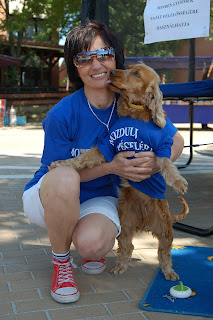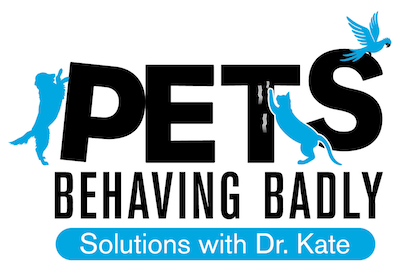The email went on to explain that the dog has never bitten or made contact but that the behaviour is a concern because the family's toddler loves to interact with the dog and other children just want to hug it because of how cute it looks.
This wasn't the first email I’ve received about dogs that behave aggressively when people (especially children or strangers) get too close, hug or manhandle a dog and it won’t be the last. In fact, in my work as an animal behaviourist and consultant, human-directed aggression is a common issue I’m called in to assist with.
 |
| Image 1: Do you think this dog is enjoying being hugged? |
What’s wrong with hugging dogs?
So why do
some dogs respond aggressively to being hugged? What’s wrong with hugging dogs?
It’s how we show them we love them so it must be ok, right? The answer may
surprise you…
Research looking into this phenomenon is lacking in the scientific literature. However, this issue came to light recently when canine behaviour expert Stanley Coren wrote an article for Psychology Today about an informal study he did (not published in the scientific literature) in which photos of people hugging dogs, freely available on the internet, were analysed for signs of canine stress or anxiety.
The results of this study indicated that about 82% of the dogs in the photos showed some sign of discomfort, stress or anxiety. Not surprisingly, this article caused some controversy, upsetting many dog owners who take pleasure in hugging their dogs.
Research looking into this phenomenon is lacking in the scientific literature. However, this issue came to light recently when canine behaviour expert Stanley Coren wrote an article for Psychology Today about an informal study he did (not published in the scientific literature) in which photos of people hugging dogs, freely available on the internet, were analysed for signs of canine stress or anxiety.
The results of this study indicated that about 82% of the dogs in the photos showed some sign of discomfort, stress or anxiety. Not surprisingly, this article caused some controversy, upsetting many dog owners who take pleasure in hugging their dogs.
Hugging is
a form of intimacy found in all human societies. We
inherited this tendency from our closest relatives, chimpanzees, who also hug
and kiss one another. So it’s not surprising that humans use hugs as a
reward for their dogs. The thing is, dogs don’t hug one another and have
not evolved to understand what a human hug means. The closest thing that dogs
might do to each other that resembles a hug is mounting - both a sexual
behaviour and one used to communicate dominance1 - or during an
argument (see image #2 below). So what kind of message are we sending our dogs
when we hug them?! The answer lies in their body language…
 |
| Image 2: These dogs may look like they're hugging but they're actually fighting. Credit: David Shankbone CC BY-SA 2.5-2.0-1.0 via Wikimedia Commons |
How can I tell if my dog enjoys being hugged?
I used to hug my dogs too, especially my Boxer, Archie who sadly passed away in 2015. I could tell he didn’t enjoy it as much as I did. Rather, he tolerated it. I did it because I enjoyed it and it felt good but rarely did I stop and think, is he really ok with being hugged, until I knew better. Like many dog owners, I assumed he understood the sentiments behind the hug. Our late Labrador Joe was never into hugs and never sought them out but our newest dog Lenny, who we adopted in 2017, is absolutely MAD for hugs. He seeks them out several times per day and during most of our interactions with him. I should clarify that Lenny enjoys hugs from me and my husband but sometimes shows mild stress signals (licking his lips and whale eye) if either of my two young children (3 and 4 years old) sneak in a hug.
Something else to consider is that not all hugs are equal and different styles of hugs may be tolerated, or even enjoyed, more than others. For example, a bear hug with both arms tightly held around a dog’s neck, shoulders or body (see images 3 & 4) is more likely to cause stress because it momentarily immobilises the dog. In contrast, a familiar arm over a dog that’s comfortably resting combined with gentle patting or stroking or cradling a puppy while it's sleeping (see image 5) are likely to be pleasurable and enjoyable for both parties. Archie our Boxer preferred this style of hug to a bear hug and once this became blindingly obvious to me, I changed the way I hugged him.
Something else to consider is that not all hugs are equal and different styles of hugs may be tolerated, or even enjoyed, more than others. For example, a bear hug with both arms tightly held around a dog’s neck, shoulders or body (see images 3 & 4) is more likely to cause stress because it momentarily immobilises the dog. In contrast, a familiar arm over a dog that’s comfortably resting combined with gentle patting or stroking or cradling a puppy while it's sleeping (see image 5) are likely to be pleasurable and enjoyable for both parties. Archie our Boxer preferred this style of hug to a bear hug and once this became blindingly obvious to me, I changed the way I hugged him.
 |
| Image 3: This dog may appear to be enjoying the hug and "kissing" it's owner. but looks can be deceiving - licking the owners face is an appeasement behaviour. |
 |
| Image 4: A different style of hug but still this dog is uncomfortable. |
 |
| Image 5: This puppy is calm and relaxed being held and stroked. |
You can
tell if your dog enjoys hugs and what kind of hug it prefers by observing it’s
body language. Signs of stress that indicate hugs may not be your dogs thing
include: lip licking, whale eye (whites of the eyes clearly visible), ears held
back or down, turning away, yawning, avoiding eye contact, panting, lifting a
paw and avoidance. More overt body
language which indicates you should immediately stop hugging your dog include
baring teeth, growling, snapping, nipping and biting.
Signs of a dog that is relaxed and potentially enjoying being hugged can include a loose body, soft/squinty/closed eyes, a relaxed mouth and facial expression, lying down, head resting on you, ears in a neutral position and steady breathing (see image 5 again). For more information on reading canine body language, including signs of stress/anxiety or relaxation, see this article.
Signs of a dog that is relaxed and potentially enjoying being hugged can include a loose body, soft/squinty/closed eyes, a relaxed mouth and facial expression, lying down, head resting on you, ears in a neutral position and steady breathing (see image 5 again). For more information on reading canine body language, including signs of stress/anxiety or relaxation, see this article.
I'm not saying you should never hug your dog again. The take
home message here is not to assume all dogs like hugs because it's quite likely the opposite is true. Rather, I suggest erring on the side of caution, especially if
you have a dog with an unknown history, young children or a dog that is fearful
or anxious. Don’t hug dogs you don’t know. You have no idea of their
temperament, personality or past experiences. Even if it’s the cutest damn dog you’ve
ever seen. You wouldn’t hug a complete stranger and, even if you did,
you would stop if they told you too.
Teach children not to hug (or even approach) dogs they don’t know. Teach them that dogs prefer a gentle scratch under the chin or on their chest, shoulder or back - and only if they are relaxed and approach calmly of their own accord to interact. Just as we wouldn’t expect a child to hug or kiss a complete stranger it’s unfair to expect our dogs to tolerate the same thing from people or children they don't know.
Dogs probably tolerate hugs from people they have a strong attachment bond, and trusting relationship with, but that doesn’t mean we should expect them to tolerate a hug from anyone, let alone a complete stranger. You can learn more about how to "ask" your dog if they'd like a pat or a hug by watching this excellent YouTube video.
Dr Kate x
Teach children not to hug (or even approach) dogs they don’t know. Teach them that dogs prefer a gentle scratch under the chin or on their chest, shoulder or back - and only if they are relaxed and approach calmly of their own accord to interact. Just as we wouldn’t expect a child to hug or kiss a complete stranger it’s unfair to expect our dogs to tolerate the same thing from people or children they don't know.
Dogs probably tolerate hugs from people they have a strong attachment bond, and trusting relationship with, but that doesn’t mean we should expect them to tolerate a hug from anyone, let alone a complete stranger. You can learn more about how to "ask" your dog if they'd like a pat or a hug by watching this excellent YouTube video.
Dr Kate x
References:
Overall,
K. L. (1997). Clinical behavioral medicine for small animals. Mosby-Year
Book, Inc..
